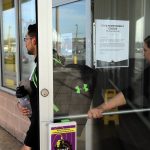PITTSTON TWP. — Food pantries throughout Northeast Pennsylvania have been seeing an increased demand from people hit hard by the COVID-19 pandemic, said Gene Brady, executive director or the Commission on Economic Opportunity.
Since the beginning of the pandemic in March, volunteers for CEO’s Weinberg Northeast Regional Food Bank have been packing food in the former Walmart building on Oak Street for people in need.
Mericle Commercial Real Estate Services has been allowing volunteers to temporarily use the building for free to serve the increased number of people, Brady said.
CEO previously provided more than 1 million pounds of food to people in need each month. That number doubled to 2 million pounds each month during the pandemic, he said.
On Tuesday, state Agriculture Secretary Russell Redding and Human Services Secretary Teresa Miller volunteered to pack food.
Redding and Miller visited the area for “Hunger Action Month,” which recognizes the prevalence of hunger across Pennsylvania.
“Typically in September, we highlight food insecurity needs throughout Pennsylvania,” Miller said. “This year, what we’ve seen is much different.”
Miller said there has been an increased demand for food as people have been out of work or their hours were cut and schools were shut down.
“Local charitable food networks like this saw a huge spike,” Miller said. “They’re seeing twice the demand they saw in a typical year.”
Prior to the pandemic, Redding said about 250,000 people would go to food pantries in a typical week. That number doubled to about 500,000 and jumped as high as 725,000, he said.
“The need has not diminished. It continues to be there,” Redding said. “It’s primarily because of job losses. We still see modified schedules of schools.”
In addition to the increased need for food throughout Northeast Pennsylvania and statewide, Miller said there also has been a rising demand for SNAP benefits.
In the first four months of the pandemic, Miller said the number of people who received SNAP benefits jumped from about 1.7 million Pennsylvanians to about 1.9 million. The number is now down to about 1.83 million, she said.

Denise Allabaugh is a business writer for The Citizens’ Voice. Contact her at dallabaugh@citizensvoice.com, 570-821-2115 or @CVAllabaugh on Twitter.




